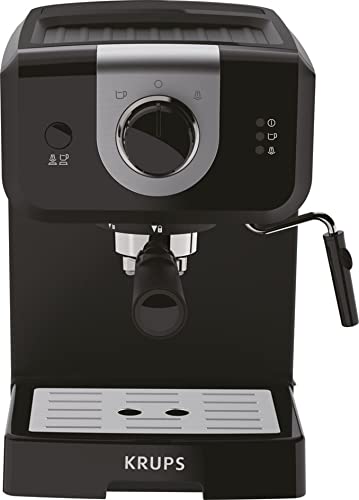- 작성자 Margarette
- 댓글 0건
- 조회 94회
- 작성일 2025.07.30
본문

Heat Exchange Espresso Machines: A Comprehensive Guide
Espresso machines have evolved substantially for many years, accommodating the needs of home baristas and coffee specialists alike. Among these machines, heat exchange espresso machines have acquired appeal due to their capability to provide constant performance and exceptional brew quality. In this post, we will check out the workings, advantages, and important features of heat exchange espresso machines, offering a thorough understanding for both prospective purchasers and coffee enthusiasts.
Comprehending Heat Exchange Technology
Heat exchange espresso machines operate on an unique concept that allows synchronised water heating for brewing and steaming. They are geared up with a single boiler that makes use of a heat exchanger system. This feature is significant as it enables users to brew espresso while steaming milk simultaneously, promoting efficiency in the coffee-making procedure.

How Does a Heat Exchange Espresso Machine Work?
The procedure begins with the machine's water inlet filling the boiler. As the water warms up, it turns to steam. The ingenious heat exchanger uses hot steam to heat extra water in a different passage developed specifically for the brew group. This suggests that water can reach the perfect brewing temperature without waiting for the boiler to change. The essential steps include:
- Water Fill: Water is drawn into the boiler.
- Heating Process: The boiler warms up as water is transformed into steam.
- Heat Exchange: Steam heats up water in the heat exchanger tube.
- Developing: Water from the heat exchanger is pushed through coffee premises, drawing out the tastes needed for an abundant espresso.
This process permits fast temperature level changes and improved coffee extraction.
Advantages of Heat Exchange Espresso Machines
Heat exchange espresso Machines espresso offer several benefits, especially for those seeking to optimize their coffee experience. Here are some key benefits:
- Simultaneous Brewing and Steaming: Users can brew espresso while steaming milk, making it perfect for hectic cafes and home baristas who value performance.
- Temperature level Stability: The boiler's steam pressure assists keep a steady temperature level, which is vital for consistent espresso extraction.
- Flexibility: The style enables quick switching between brewing and steaming, making it easier to produce numerous coffee drinks, from lattes to cappuccinos.
- User-friendly: Models typically include available controls, making it feasible for both newbies and knowledgeable baristas to produce quality beverages.
- Professional Quality: Heat exchange machines are frequently used in commercial settings, offering users with high-quality developing efficiency in your home.
Secret Features to Look for in Heat Exchange Espresso Machines
When considering the purchase of a heat exchange espresso machine, there are a number of functions that a person must take into consideration:
- Build Quality: Look for machines made of durable materials, such as stainless steel or brass, ensuring durability.
- Boiler Size: A larger boiler will hold more water and sustain greater output over time.
- PID Temperature Control: This function assists keep constant brew temperature levels, which can improve the coffee-making procedure.
- Group Head Design: Machines with a saturated or semi-saturated group head provide much better temperature level stability.
- Reduce of Use: User-friendly user interfaces and instinctive controls boost the total experience for baristas at all skill levels.
- Steam Wand Quality: An excellent steam wand with correct insulation and flexibility enables much better texturing of milk.
- Water Reservoir Size: Depending on your requirements, consider how frequently you wish to fill up the water tank.
Comparison of Popular Heat Exchange Espresso Machines
To better understand the choices available in the market, listed below is a contrast table of some popular heat exchange espresso machines:
| Machine Model | Boiler Size | PID Control | Cost Range | User Ratings |
|---|---|---|---|---|
| Profitec Pro 700 | 2.0 L | Yes | ₤ 2,000-₤ 2,500 | 9.5/ 10 |
| Rocket Espresso R58 | 1.8 L | Yes | ₤ 2,400-₤ 2,800 | 9.4/ 10 |
| Elekta Bianca | 1.8 L | Yes | ₤ 2,500-₤ 3,000 | 9.6/ 10 |
| La Spaziale S1 Vivaldi II | 1.5 L | Yes | ₤ 1,800-₤ 2,200 | 9.2/ 10 |
| Bezzera Magica | 1.2 L | No | ₤ 1,600-₤ 1,800 | 9.0/ 10 |
FAQs About Heat Exchange Espresso Machines
What is the main difference between a heat exchange and a dual boiler espresso machine?
While both types can brew espresso and steam milk at the same time, dual boiler machines have different boilers for brewing and steaming. On the other hand, heat exchange machines make use of a single boiler and a heat exchanger to accomplish the same function.
Are heat exchange machines ideal for newbies?
Yes! Numerous heat exchange machines are developed with easy to use functions, making them available for beginners. With proper guidance and practice, users can rapidly produce quality espresso.
What sort of upkeep do heat exchange espresso machines need?
Regular maintenance consists of descaling, cleaning up the boiler, inspecting seals and gaskets, and keeping the group head tidy. Routine upkeep ensures longevity and constant efficiency.
Can I use a heat exchange machine for various kinds of coffee drinks?
Absolutely! Heat exchange machines allow users to create a range of coffee drinks, including espresso, lattes, cappuccinos, and more.
Heat exchange espresso machines represent a mix of development and custom, supplying coffee lovers with the tools required for crafting the ideal cup. Their capability to simultaneously brew and steam, combined with precise temperature control, makes them a compelling option for both home baristas and professionals. With the best understanding on features and upkeep, users can unlock a world of elegant coffee experiences, guaranteeing that each sip is as wonderful as the last.
댓글목록 0개
등록된 댓글이 없습니다.

